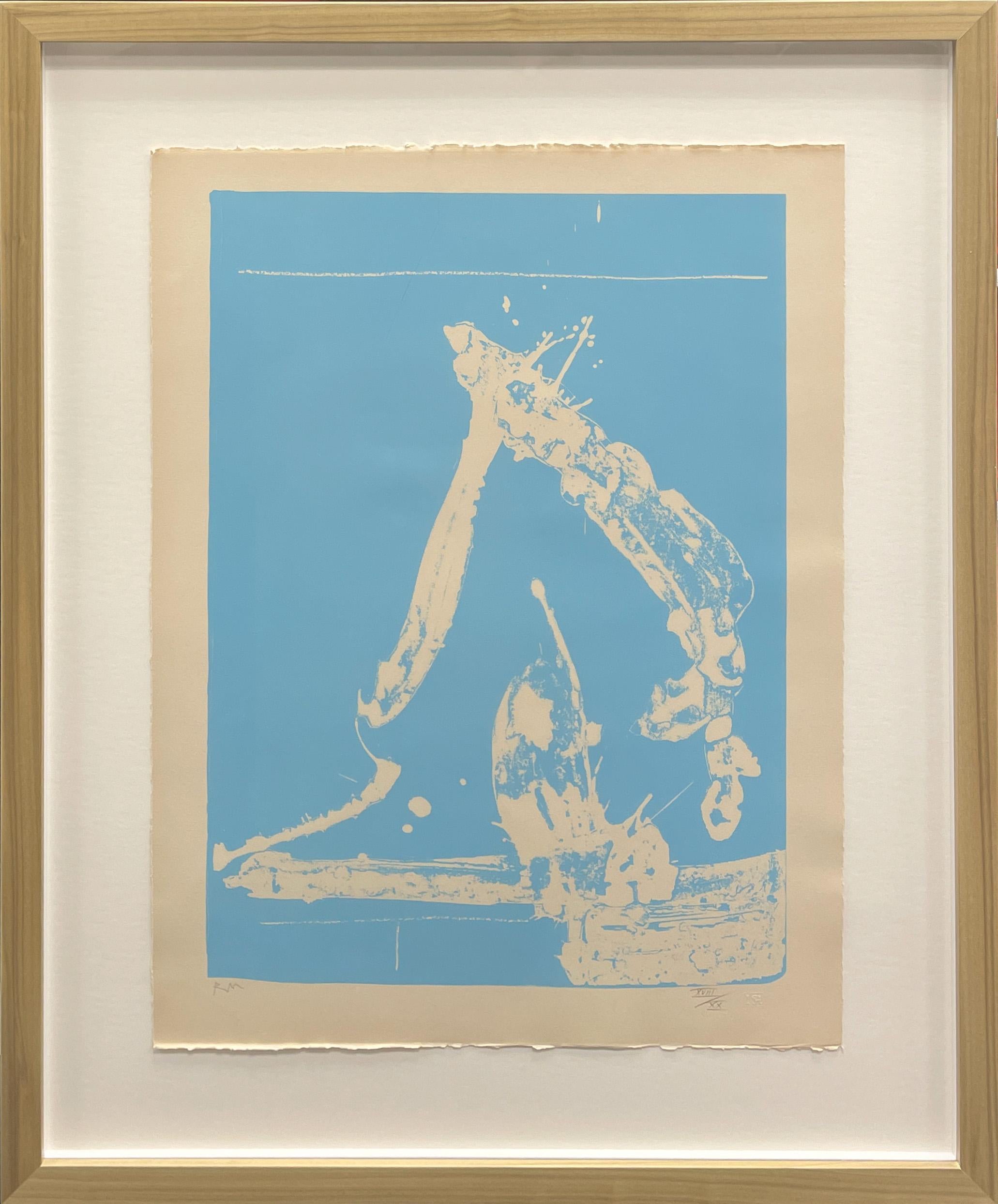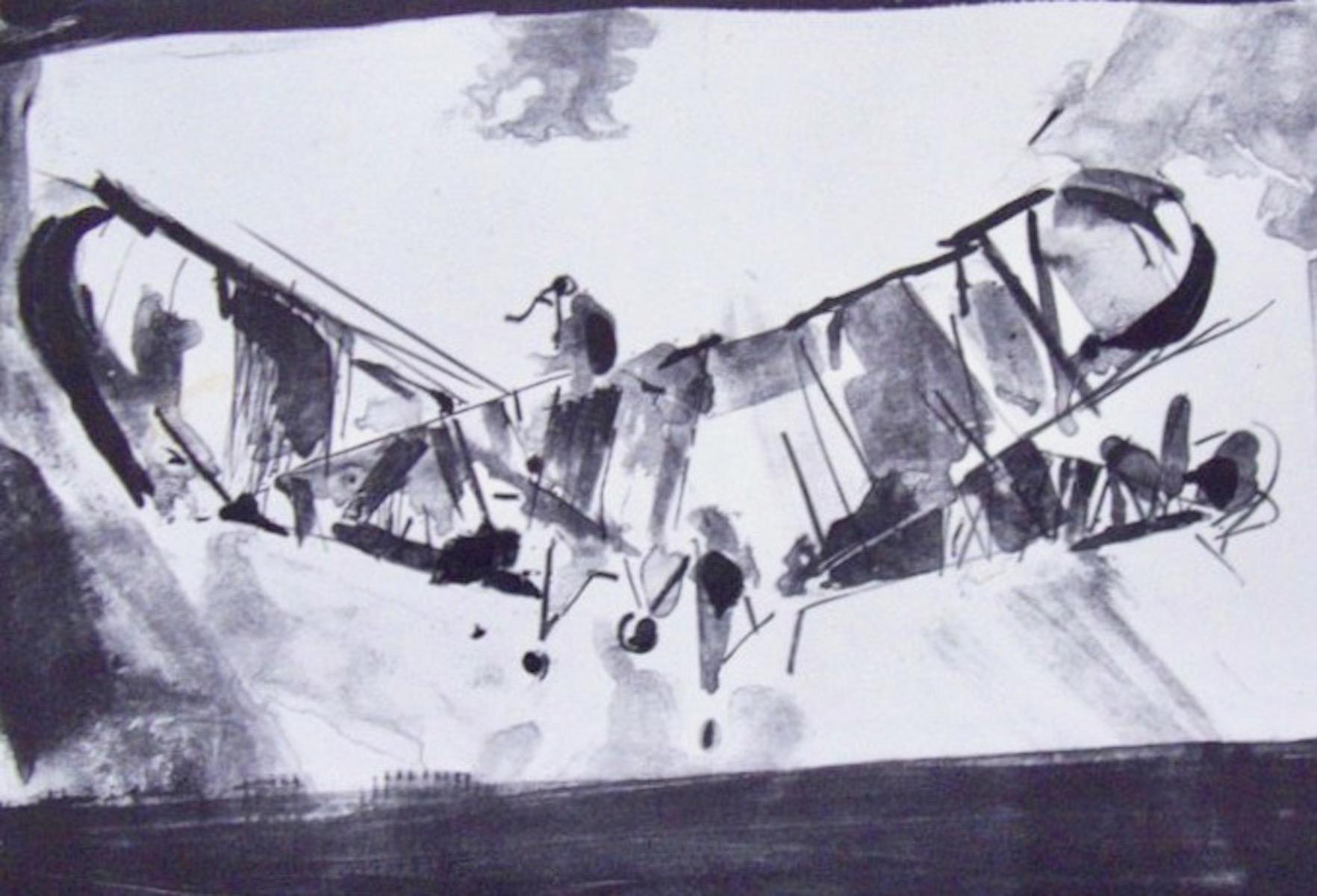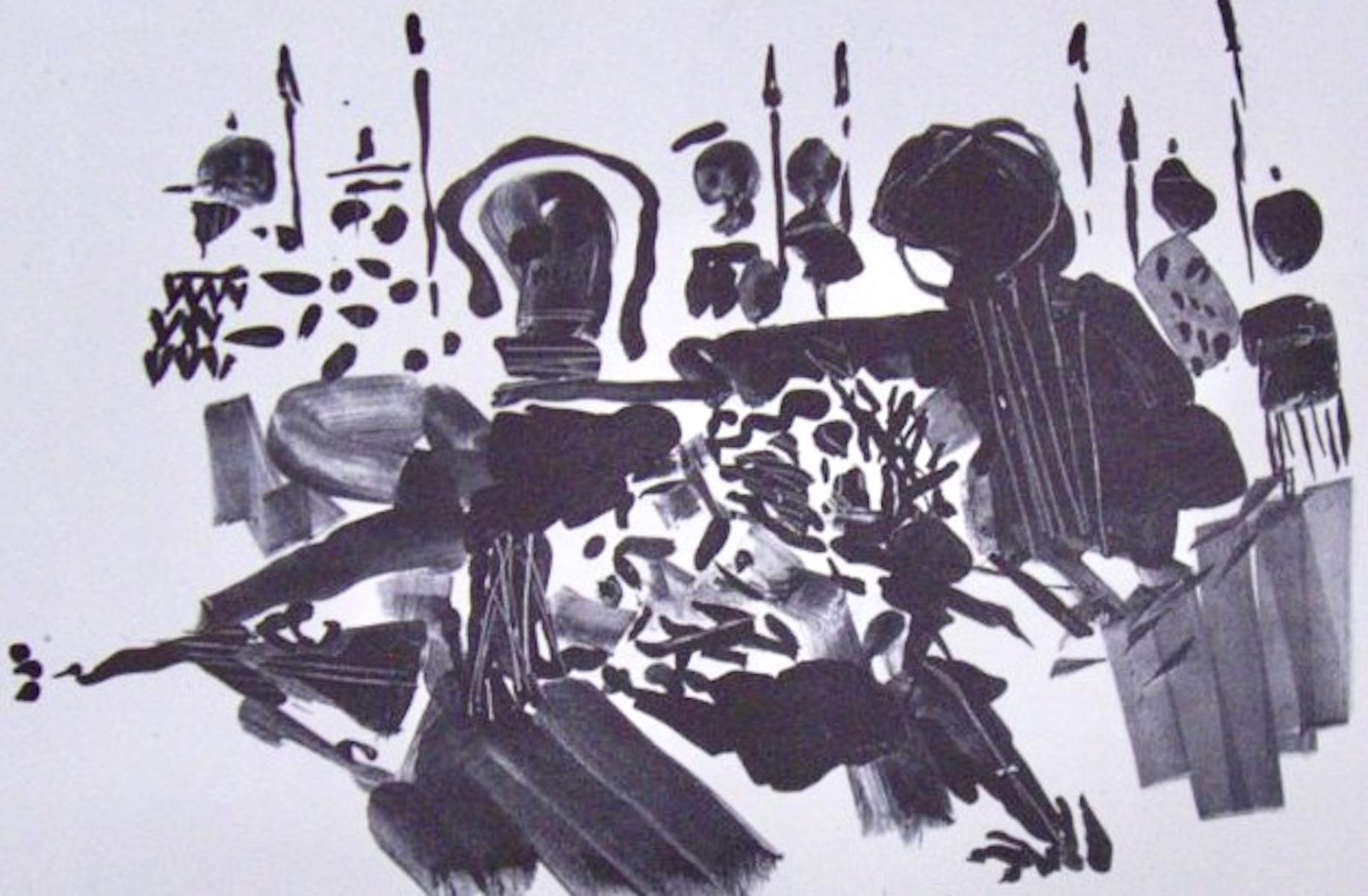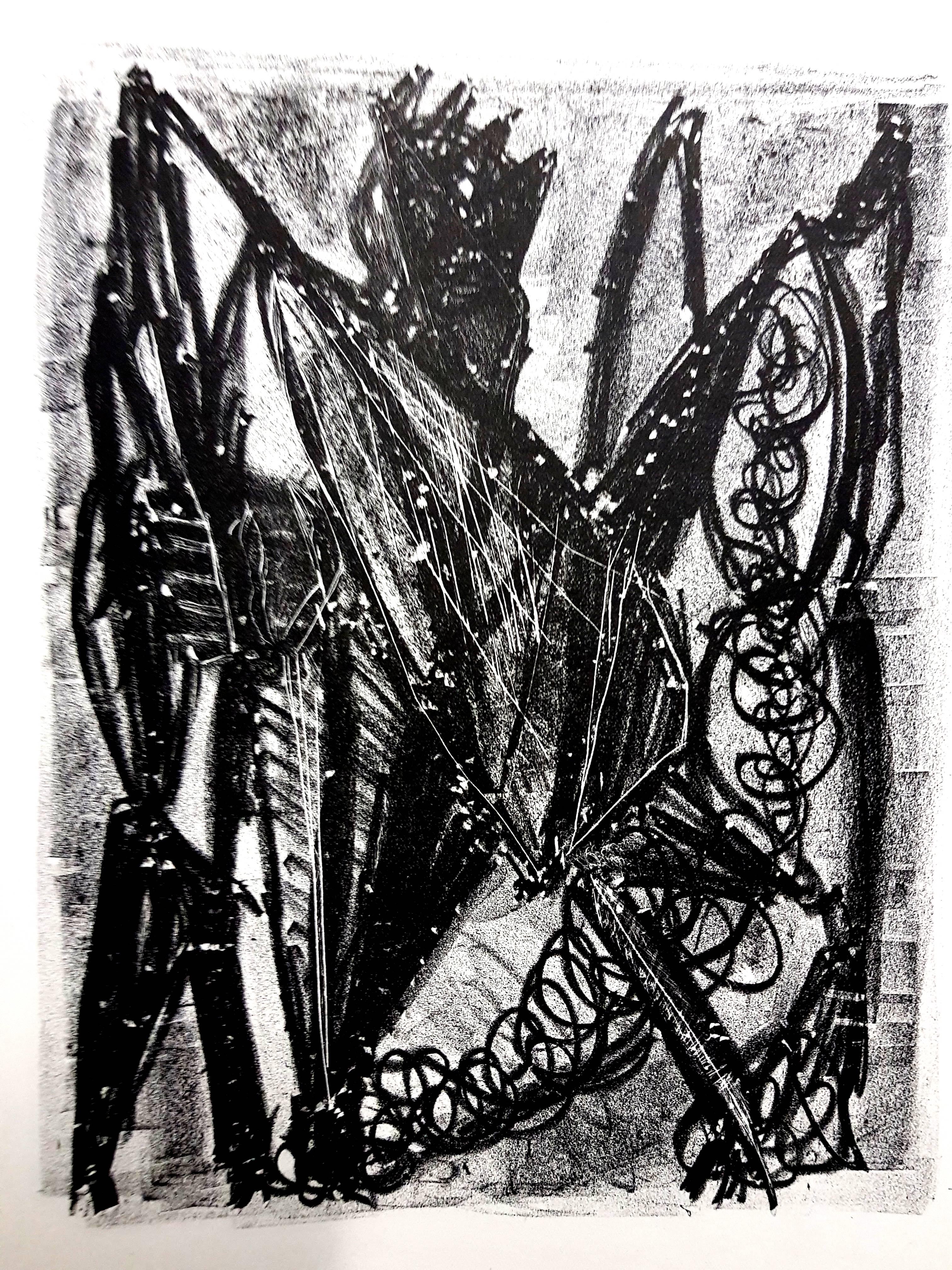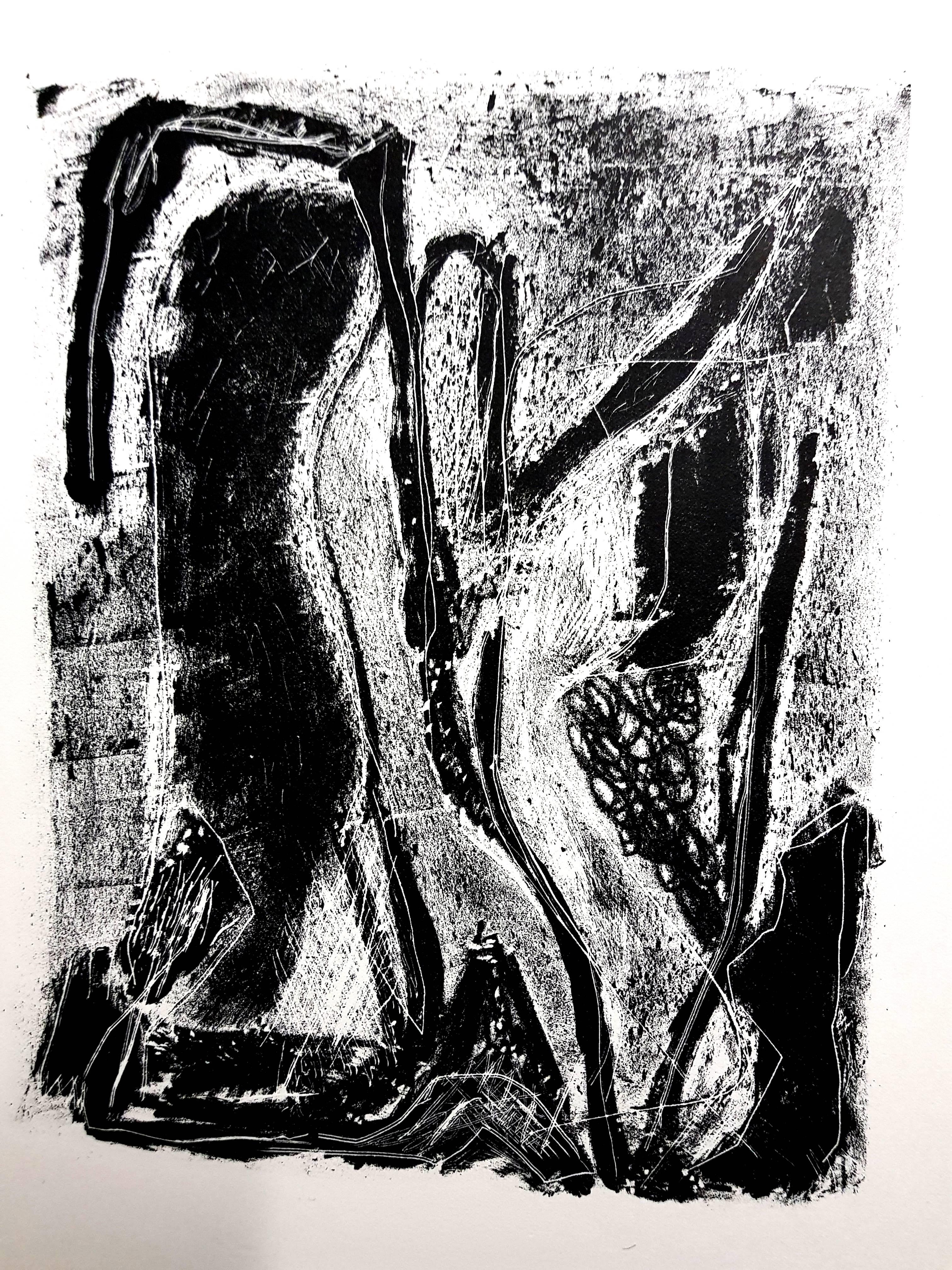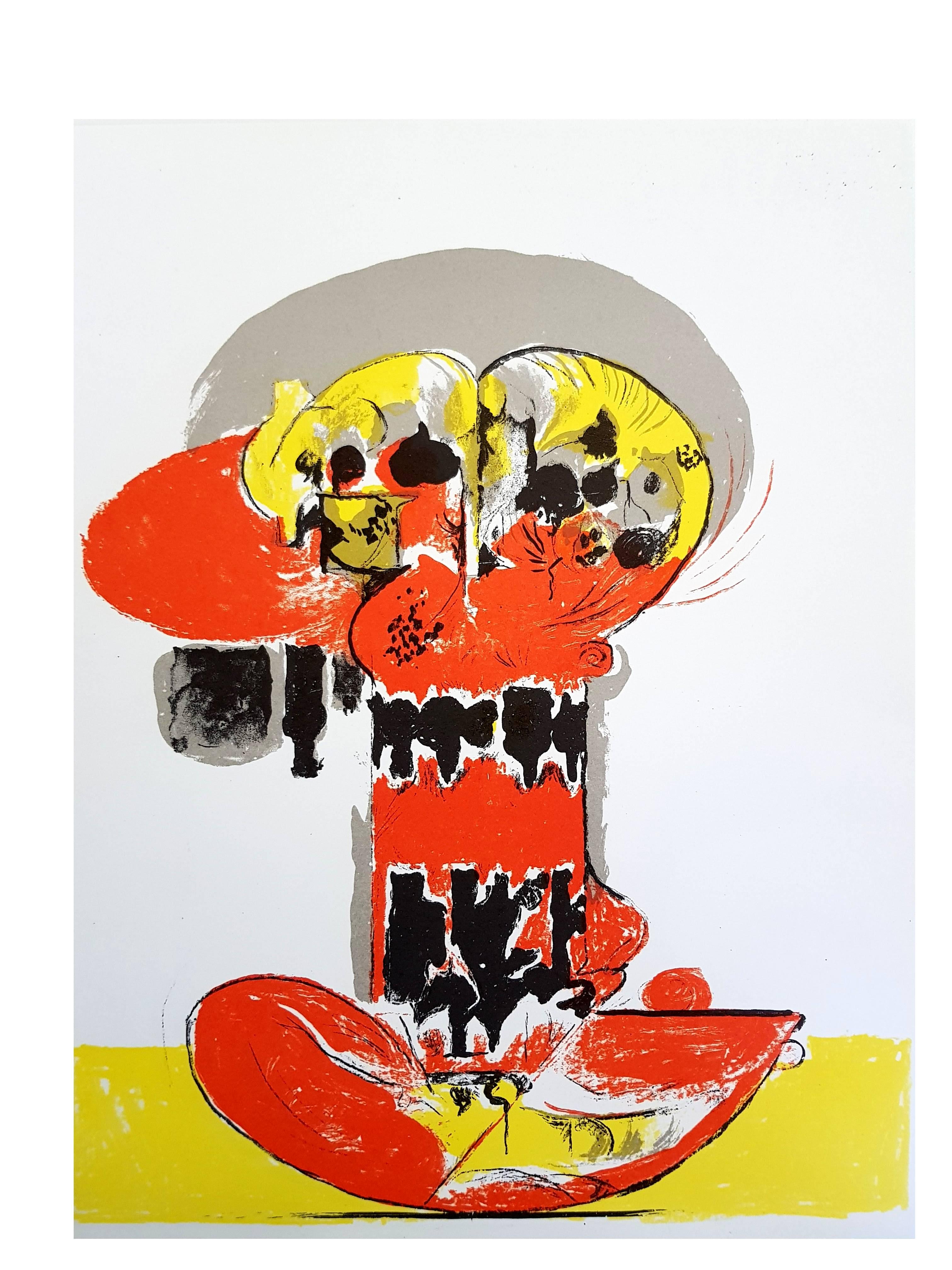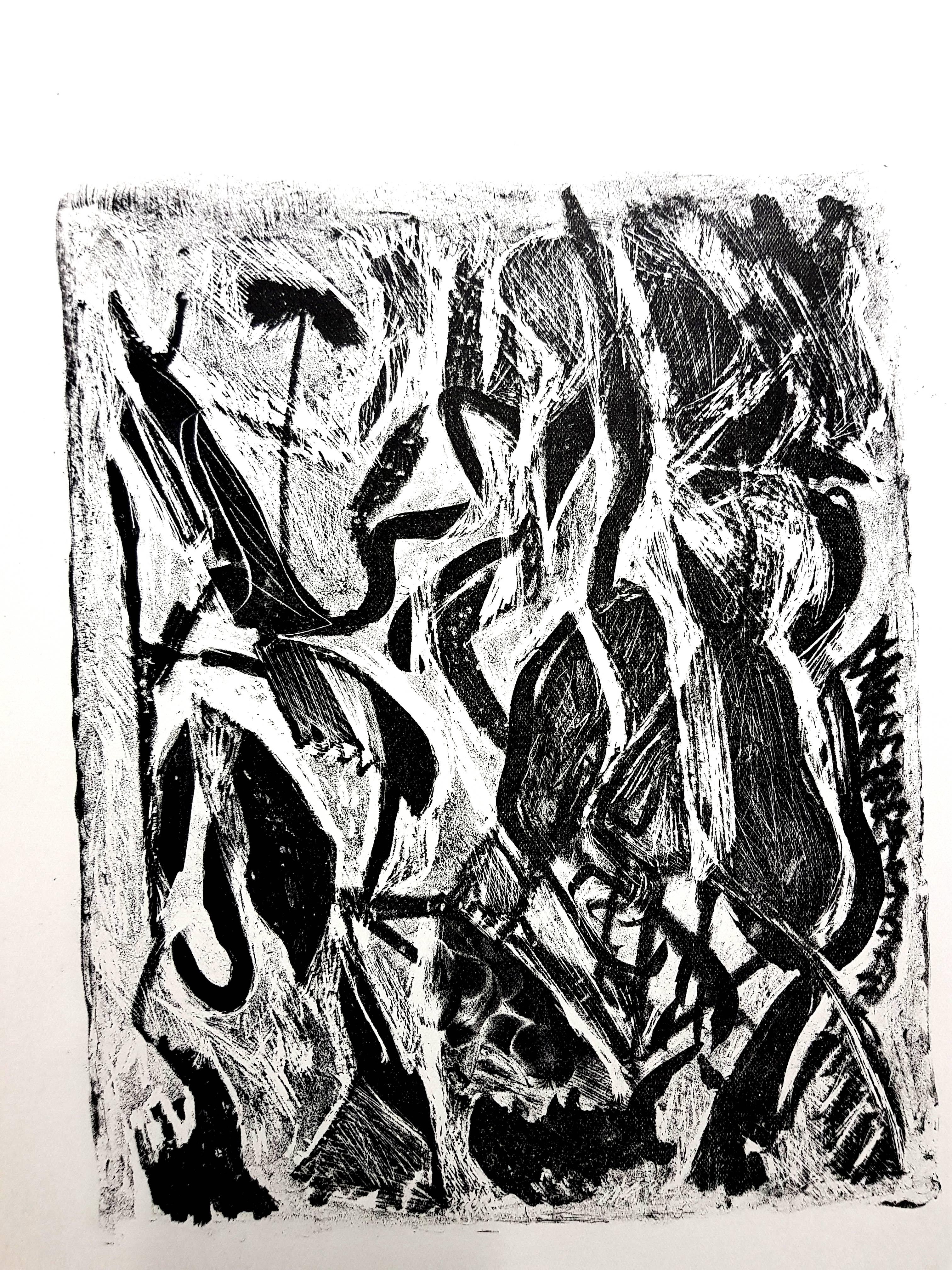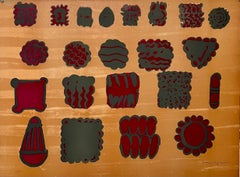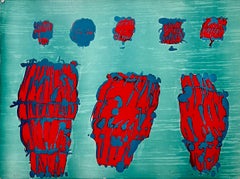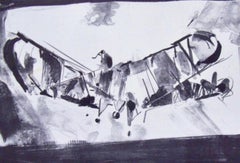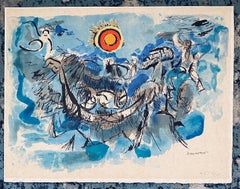
Large American Abstract Expressionist Bold Colorful Lithograph
View Similar Items
Want more images or videos?
Request additional images or videos from the seller
1 of 11
Abraham RattnerLarge American Abstract Expressionist Bold Colorful Lithographc.1960s
c.1960s
About the Item
- Creator:Abraham Rattner (1895-1978, American)
- Creation Year:c.1960s
- Dimensions:Height: 19.5 in (49.53 cm)Width: 25.5 in (64.77 cm)
- Medium:
- Movement & Style:
- Period:
- Condition:minor edge wear. Please see Photos.
- Gallery Location:Surfside, FL
- Reference Number:1stDibs: LU3826461912
About the Seller
4.9
Platinum Seller
These expertly vetted sellers are 1stDibs' most experienced sellers and are rated highest by our customers.
Established in 1995
1stDibs seller since 2014
1,539 sales on 1stDibs
Typical response time: 1 hour
More From This SellerView All
- Pietro Consagra Italian Mod Abstract Expressionist Forma, Art Brut LithographBy Pietro ConsagraLocated in Surfside, FLPietro Consagra (Italian, 1920-2005). Hand signed in pencil and numbered limited edition color lithograph on Magnani paper. Embossed stamp with limited edition numbers in pencil to lower left, and having artist pencil signature to lower right. (from a limited edition of 80 with 15 artist's proofs) Published by Stamperia 2RC, Rome Italy and Marlborough Gallery, Rome, Italy. Abstract Modernist work in colors, produced in the style of the Forma art movement of Postwar Italy, of which the artist was a prominent member. Pietro Consagra (1920 – 2005) was an Italian Post war artist working in painting, printmaking and sculpture. In 1947 he was among the founding members of the Forma 1 group of artists, proponents of structured abstraction. (similar to the Art Informel and Art Brut in France and the Brutalist artists) Consagra was born on 6 October 1920 in Mazara del Vallo, in the province of Trapani in south-western Sicily, to Luigi Consagra and Maria Lentini. From 1931 he enrolled in a trade school for sailors, studying first to become a mechanic, and later to become a captain. In 1938 he moved to Palermo, where he enrolled in the liceo artistico; despite an attack of tuberculosis, he graduated in 1941, and in the same year signed up at the Accademia di Belle Arti, where he studied sculpture under Archimede Campini. After the Invasion of Sicily and the Allied occupation of Palermo in 1943, Consagra found work as a caricaturist for the American Red Cross club of the city; he also joined the Italian Communist Party. Early in 1944, armed with a letter of introduction from an American officer, he travelled to Rome. There he came into contact with the Sicilian artist Concetto Maugeri, and through him with Renato Guttuso, who was also Sicilian and who introduced him to the intellectual life of the city and to other postwar artists such as Leoncillo Leonardi, Mario Mafai and Giulio Turcato. Consagra signed up at the Accademia di Belle Arti di Roma in September 1944 and studied sculpture there under Michele Guerrisi, but left before completing his diploma. In 1947, with Carla Accardi, Ugo Attardi, Piero Dorazio, Mino Guerrini, Achille Perilli, Antonio Sanfilippo and Giulio Turcato, Consagra started the artist's group Forma 1, which advocated both Marxism and structured abstraction. Steadily Consagra's work began to find an audience. Working primarily in metal, and later in marble and wood, his thin, roughly carved reliefs, began to be collected by Peggy Guggenheim and other important patrons of the arts. He showed at the Venice Biennale eleven times between 1950 and 1993, and in 1960 won the sculpture prize at the exhibition. During the 1960s he was associated with the Continuità group, an offshoot of Forma I, and in 1967 taught at the School of Arts in Minneapolis. Large commissions allowed him to begin working on a more monumental scale, and works of his were installed in the courtyard of the Foreign Ministry in Rome and in the European Parliament, Strasbourg. His work is found in the collections of The Tate Gallery, London, in Museo Cantonale d'Arte of Lugano and the Museum of Modern Art, Paris, and the National Gallery of Art in Washington, D.C.. Consagra returned to Sicily where he sculpted a number of significant works during the 1980s. With Senator Ludovico Corrao, he helped created an open-air museum in the new town of Gibellina, after the older town had been destroyed in the earthquake of 1968. Consagra designed the gates to the town's entrance, the building named "Meeting" and the gates to the cemetery, where he was later buried. In 1952 Consagra published La necessità della scultura ("the need for sculpture"), a response to the essay La scultura lingua morta ("sculpture, a dead language"), published in 1945 by Arturo Martini. Other works include L'agguato c'è ("the snare exists", 1960), and La città frontale ("the frontal city", 1969). His autobiography, Vita Mia, was published by Feltrinelli in 1980. In 1989 a substantial retrospective exhibition of work by Consagra was shown at the Galleria Nazionale d'Arte Moderna in Rome; in 1993 a permanent exhibition of his work was installed there. In 1991 his work was shown in the Hermitage Museum in St. Petersburg. In 2002 the Galerie der Stadt Stuttgart opened a permanent exhibition of his work. He was one of ten artists invited by Giovanni Carandente, along with David Smith, Alexander Calder, Arnaldo Pomodoro, Lynn Chadwick, and Beverly Pepper, to fabricate works in Italsider factories in Italy for an outdoor exhibition, "Sculture nella città", held in Spoleto during the summer of 1962. He was included in the The 1962 International Prize for Sculpture the jury included Argan, Romero Brest and James Johnson Sweeney the former director of the Solomon R. Guggenheim Museum in New York. The participants included Louise Nevelson and John Chamberlain for the United States; Lygia Clark for Brazil; Pietro Consagra, Lucio Fontana, Nino Franchina, and Gió Pomodoro for Italy; Pablo Serrano for Spain; and Eduardo Paolozzi, William Turnbull, and Kenneth Armitage for England. Gyula Kosice, Noemí Gerstein, Julio Gero, Naum Knop...Category
1960s Abstract Expressionist Abstract Prints
MaterialsLithograph
- Pietro Consagra Italian Mod Abstract Expressionist Forma, Art Brut LithographBy Pietro ConsagraLocated in Surfside, FLPietro Consagra (Italian, 1920-2005). Hand signed in pencil and numbered limited edition color lithograph on Magnani paper. Embossed stamp with limited edition numbers in pencil to lower left, and having artist pencil signature to lower right. (from a limited edition of 80 with 15 artist's proofs) Published by Stamperia 2RC, Rome Italy and Marlborough Gallery, Rome, Italy. Abstract Modernist work in colors, produced in the style of the Forma art movement of Postwar Italy, of which the artist was a prominent member. Pietro Consagra (1920 – 2005) was an Italian Post war artist working in painting, printmaking and sculpture. In 1947 he was among the founding members of the Forma 1 group of artists, proponents of structured abstraction. (similar to the Art Informel and Art Brut in France and the Brutalist artists) Consagra was born on 6 October 1920 in Mazara del Vallo, in the province of Trapani in south-western Sicily, to Luigi Consagra and Maria Lentini. From 1931 he enrolled in a trade school for sailors, studying first to become a mechanic, and later to become a captain. In 1938 he moved to Palermo, where he enrolled in the liceo artistico; despite an attack of tuberculosis, he graduated in 1941, and in the same year signed up at the Accademia di Belle Arti, where he studied sculpture under Archimede Campini. After the Invasion of Sicily and the Allied occupation of Palermo in 1943, Consagra found work as a caricaturist for the American Red Cross club of the city; he also joined the Italian Communist Party. Early in 1944, armed with a letter of introduction from an American officer, he travelled to Rome. There he came into contact with the Sicilian artist Concetto Maugeri, and through him with Renato Guttuso, who was also Sicilian and who introduced him to the intellectual life of the city and to other postwar artists such as Leoncillo Leonardi, Mario Mafai and Giulio Turcato. Consagra signed up at the Accademia di Belle Arti di Roma in September 1944 and studied sculpture there under Michele Guerrisi, but left before completing his diploma. In 1947, with Carla Accardi, Ugo Attardi, Piero Dorazio, Mino Guerrini, Achille Perilli, Antonio Sanfilippo and Giulio Turcato, Consagra started the artist's group Forma 1, which advocated both Marxism and structured abstraction. Steadily Consagra's work began to find an audience. Working primarily in metal, and later in marble and wood, his thin, roughly carved reliefs, began to be collected by Peggy Guggenheim and other important patrons of the arts. He showed at the Venice Biennale eleven times between 1950 and 1993, and in 1960 won the sculpture prize at the exhibition. During the 1960s he was associated with the Continuità group, an offshoot of Forma I, and in 1967 taught at the School of Arts in Minneapolis. Large commissions allowed him to begin working on a more monumental scale, and works of his were installed in the courtyard of the Foreign Ministry in Rome and in the European Parliament, Strasbourg. His work is found in the collections of The Tate Gallery, London, in Museo Cantonale d'Arte of Lugano and the Museum of Modern Art, Paris, and the National Gallery of Art in Washington, D.C.. Consagra returned to Sicily where he sculpted a number of significant works during the 1980s. With Senator Ludovico Corrao, he helped created an open-air museum in the new town of Gibellina, after the older town had been destroyed in the earthquake of 1968. Consagra designed the gates to the town's entrance, the building named "Meeting" and the gates to the cemetery, where he was later buried. In 1952 Consagra published La necessità della scultura ("the need for sculpture"), a response to the essay La scultura lingua morta ("sculpture, a dead language"), published in 1945 by Arturo Martini. Other works include L'agguato c'è ("the snare exists", 1960), and La città frontale ("the frontal city", 1969). His autobiography, Vita Mia, was published by Feltrinelli in 1980. In 1989 a substantial retrospective exhibition of work by Consagra was shown at the Galleria Nazionale d'Arte Moderna in Rome; in 1993 a permanent exhibition of his work was installed there. In 1991 his work was shown in the Hermitage Museum in St. Petersburg. In 2002 the Galerie der Stadt Stuttgart opened a permanent exhibition of his work. He was one of ten artists invited by Giovanni Carandente, along with David Smith, Alexander Calder, Arnaldo Pomodoro, Lynn Chadwick, and Beverly Pepper, to fabricate works in Italsider factories in Italy for an outdoor exhibition, "Sculture nella città", held in Spoleto during the summer of 1962. He was included in the The 1962 International Prize for Sculpture the jury included Argan, Romero Brest and James Johnson Sweeney the former director of the Solomon R. Guggenheim Museum in New York. The participants included Louise Nevelson and John Chamberlain for the United States; Lygia Clark for Brazil; Pietro Consagra, Lucio Fontana, Nino Franchina, and Gió Pomodoro for Italy; Pablo Serrano for Spain; and Eduardo Paolozzi, William Turnbull, and Kenneth Armitage for England. Gyula Kosice, Noemí Gerstein, Julio Gero, Naum Knop...Category
1960s Abstract Expressionist Abstract Prints
MaterialsLithograph
- Pietro Consagra Italian Mod Abstract Expressionist Forma Brutalist LithographBy Pietro ConsagraLocated in Surfside, FLPietro Consagra (Italian, 1920-2005). Hand signed in pencil and numbered limited edition color lithograph on Magnani paper. Embossed stamp with limited edition numbers in pencil to lower left, and having artist pencil signature to lower right. (from a limited edition of 80 with 15 artist's proofs) Published by Stamperia 2RC, Rome Italy and Marlborough Gallery, Rome, Italy. Abstract Modernist work in colors, produced in the style of the Forma art movement of Postwar Italy, of which the artist was a prominent member. Pietro Consagra (1920 – 2005) was an Italian Post war artist working in painting, printmaking and sculpture. In 1947 he was among the founding members of the Forma 1 group of artists, proponents of structured abstraction. Consagra was born on 6 October 1920 in Mazara del Vallo, in the province of Trapani in south-western Sicily, to Luigi Consagra and Maria Lentini. From 1931 he enrolled in a trade school for sailors, studying first to become a mechanic, and later to become a captain. In 1938 he moved to Palermo, where he enrolled in the liceo artistico; despite an attack of tuberculosis, he graduated in 1941, and in the same year signed up at the Accademia di Belle Arti, where he studied sculpture under Archimede Campini. After the Invasion of Sicily and the Allied occupation of Palermo in 1943, Consagra found work as a caricaturist for the American Red Cross club of the city; he also joined the Italian Communist Party. Early in 1944, armed with a letter of introduction from an American officer, he travelled to Rome. There he came into contact with the Sicilian artist Concetto Maugeri, and through him with Renato Guttuso, who was also Sicilian and who introduced him to the intellectual life of the city and to other postwar artists such as Leoncillo Leonardi, Mario Mafai and Giulio Turcato. Consagra signed up at the Accademia di Belle Arti di Roma in September 1944 and studied sculpture there under Michele Guerrisi, but left before completing his diploma. In 1947, with Carla Accardi, Ugo Attardi, Piero Dorazio, Mino Guerrini, Achille Perilli, Antonio Sanfilippo and Giulio Turcato, Consagra started the artist's group Forma 1, which advocated both Marxism and structured abstraction. Steadily Consagra's work began to find an audience. Working primarily in metal, and later in marble and wood, his thin, roughly carved reliefs, began to be collected by Peggy Guggenheim and other important patrons of the arts. He showed at the Venice Biennale eleven times between 1950 and 1993, and in 1960 won the sculpture prize at the exhibition. During the 1960s he was associated with the Continuità group, an offshoot of Forma I, and in 1967 taught at the School of Arts in Minneapolis. Large commissions allowed him to begin working on a more monumental scale, and works of his were installed in the courtyard of the Foreign Ministry in Rome and in the European Parliament, Strasbourg. His work is found in the collections of The Tate Gallery, London, in Museo Cantonale d'Arte of Lugano and the Museum of Modern Art, Paris, and the National Gallery of Art in Washington, D.C.. Consagra returned to Sicily where he sculpted a number of significant works during the 1980s. With Senator Ludovico Corrao, he helped created an open-air museum in the new town of Gibellina, after the older town had been destroyed in the earthquake of 1968. Consagra designed the gates to the town's entrance, the building named "Meeting" and the gates to the cemetery, where he was later buried. In 1952 Consagra published La necessità della scultura ("the need for sculpture"), a response to the essay La scultura lingua morta ("sculpture, a dead language"), published in 1945 by Arturo Martini. Other works include L'agguato c'è ("the snare exists", 1960), and La città frontale ("the frontal city", 1969). His autobiography, Vita Mia, was published by Feltrinelli in 1980. In 1989 a substantial retrospective exhibition of work by Consagra was shown at the Galleria Nazionale d'Arte Moderna in Rome; in 1993 a permanent exhibition of his work was installed there. In 1991 his work was shown in the Hermitage Museum in St. Petersburg. In 2002 the Galerie der Stadt Stuttgart opened a permanent exhibition of his work. He was one of ten artists invited by Giovanni Carandente, along with David Smith, Alexander Calder, Arnaldo Pomodoro, Lynn Chadwick, and Beverly Pepper, to fabricate works in Italsider factories in Italy for an outdoor exhibition, "Sculture nella città", held in Spoleto during the summer of 1962. He was included in the The 1962 International Prize for Sculpture the jury included Argan, Romero Brest and James Johnson Sweeney the former director of the Solomon R. Guggenheim Museum in New York. The participants included Louise Nevelson and John Chamberlain for the United States; Lygia Clark for Brazil; Pietro Consagra, Lucio Fontana, Nino Franchina, and Gió Pomodoro for Italy; Pablo Serrano for Spain; and Eduardo Paolozzi, William Turnbull, and Kenneth Armitage for England. Gyula Kosice, Noemí Gerstein, Julio Gero, Naum Knop...Category
1960s Abstract Expressionist Abstract Prints
MaterialsLithograph
- Pietro Consagra Italian Mod Abstract Expressionist Forma Brutalist LithographBy Pietro ConsagraLocated in Surfside, FLPietro Consagra (Italian, 1920-2005). Hand signed in pencil and numbered limited edition color lithograph on Magnani paper. Embossed stamp with limited edition numbers in pencil to lower left, and having artist pencil signature to lower right. (from a limited edition of 80 with 15 artist's proofs) Published by Stamperia 2RC, Rome Italy and Marlborough Gallery, Rome, Italy. Abstract Modernist work in colors, produced in the style of the Forma art movement of Postwar Italy, of which the artist was a prominent member. Pietro Consagra (1920 – 2005) was an Italian Post war artist working in painting, printmaking and sculpture. In 1947 he was among the founding members of the Forma 1 group of artists, proponents of structured abstraction. Consagra was born on 6 October 1920 in Mazara del Vallo, in the province of Trapani in south-western Sicily, to Luigi Consagra and Maria Lentini. From 1931 he enrolled in a trade school for sailors, studying first to become a mechanic, and later to become a captain. In 1938 he moved to Palermo, where he enrolled in the liceo artistico; despite an attack of tuberculosis, he graduated in 1941, and in the same year signed up at the Accademia di Belle Arti, where he studied sculpture under Archimede Campini. After the Invasion of Sicily and the Allied occupation of Palermo in 1943, Consagra found work as a caricaturist for the American Red Cross club of the city; he also joined the Italian Communist Party. Early in 1944, armed with a letter of introduction from an American officer, he travelled to Rome. There he came into contact with the Sicilian artist Concetto Maugeri, and through him with Renato Guttuso, who was also Sicilian and who introduced him to the intellectual life of the city and to other postwar artists such as Leoncillo Leonardi, Mario Mafai and Giulio Turcato. Consagra signed up at the Accademia di Belle Arti di Roma in September 1944 and studied sculpture there under Michele Guerrisi, but left before completing his diploma. In 1947, with Carla Accardi, Ugo Attardi, Piero Dorazio, Mino Guerrini, Achille Perilli, Antonio Sanfilippo and Giulio Turcato, Consagra started the artist's group Forma 1, which advocated both Marxism and structured abstraction. Steadily Consagra's work began to find an audience. Working primarily in metal, and later in marble and wood, his thin, roughly carved reliefs, began to be collected by Peggy Guggenheim and other important patrons of the arts. He showed at the Venice Biennale eleven times between 1950 and 1993, and in 1960 won the sculpture prize at the exhibition. During the 1960s he was associated with the Continuità group, an offshoot of Forma I, and in 1967 taught at the School of Arts in Minneapolis. Large commissions allowed him to begin working on a more monumental scale, and works of his were installed in the courtyard of the Foreign Ministry in Rome and in the European Parliament, Strasbourg. His work is found in the collections of The Tate Gallery, London, in Museo Cantonale d'Arte of Lugano and the Museum of Modern Art, Paris, and the National Gallery of Art in Washington, D.C.. Consagra returned to Sicily where he sculpted a number of significant works during the 1980s. With Senator Ludovico Corrao, he helped created an open-air museum in the new town of Gibellina, after the older town had been destroyed in the earthquake of 1968. Consagra designed the gates to the town's entrance, the building named "Meeting" and the gates to the cemetery, where he was later buried. In 1952 Consagra published La necessità della scultura ("the need for sculpture"), a response to the essay La scultura lingua morta ("sculpture, a dead language"), published in 1945 by Arturo Martini. Other works include L'agguato c'è ("the snare exists", 1960), and La città frontale ("the frontal city", 1969). His autobiography, Vita Mia, was published by Feltrinelli in 1980. In 1989 a substantial retrospective exhibition of work by Consagra was shown at the Galleria Nazionale d'Arte Moderna in Rome; in 1993 a permanent exhibition of his work was installed there. In 1991 his work was shown in the Hermitage Museum in St. Petersburg. In 2002 the Galerie der Stadt Stuttgart opened a permanent exhibition of his work. He was one of ten artists invited by Giovanni Carandente, along with David Smith, Alexander Calder, Arnaldo Pomodoro, Lynn Chadwick, and Beverly Pepper, to fabricate works in Italsider factories in Italy for an outdoor exhibition, "Sculture nella città", held in Spoleto during the summer of 1962. He was included in the The 1962 International Prize for Sculpture the jury included Argan, Romero Brest and James Johnson Sweeney the former director of the Solomon R. Guggenheim Museum in New York. The participants included Louise Nevelson and John Chamberlain for the United States; Lygia Clark for Brazil; Pietro Consagra, Lucio Fontana, Nino Franchina, and Gió Pomodoro for Italy; Pablo Serrano for Spain; and Eduardo Paolozzi, William Turnbull, and Kenneth Armitage for England. Gyula Kosice, Noemí Gerstein, Julio Gero, Naum Knop...Category
1960s Abstract Expressionist Abstract Prints
MaterialsLithograph
- Large Abstract Expressionist Feminist Lithograph Incorporating Text ''FMSWNL''By Joan SnyderLocated in Surfside, FL''FMSWNL'' from the limited edition of 100. Pencil hand signed and dated. Joan Snyder, (born April 16, 1940), is an American painter from New York. She is a MacArthur Fellow, a Gu...Category
1980s Abstract Expressionist Abstract Prints
MaterialsLithograph
- Color Embossed Lithograph Print New York Abstract Expressionist Woman ArtistBy Amaranth EhrenhaltLocated in Surfside, FLThis print depicts a non-objective composition of organic shapes rendered in vibrant hues of color upon a field of a cool grey. This relief print is hand signed and titled to the lower right corner of the picture plane. From the limited edition of 50. Publishers blindstamp in lower left of sheet. (i have seen this described as a woodcut, linocut and lithograph. there is embossing. I am not sure of the exact technique.) The title is Conifer. Amaranth Roslyn Ehrenhalt (January 15, 1928) is an American painter, sculptor, and writer, who spent the majority of her career living and working in Paris, France. Ehrenhalt is one of the few abstract expressionists from the New York School of the 1950s who is still active today. She now lives and works in New York City. Born in Newark, New Jersey, Amaranth was raised in Philadelphia, Pennsylvania. As a child, she expressed a passion for art, and by the age of twelve, Amaranth was enrolled in a Saturday morning program for artistically gifted children at the Philadelphia Museum of Art, followed a few years later by art classes at Fleisher Art Memorial. Amaranth Ehrenhalt graduated from Olney High School in 1945, and went on to study for one year at the Philadelphia Museum School of Industrial Arts (now known as the University of Arts, Philadelphia), after which, she was awarded an Honors Scholarship to the Pennsylvania Academy of the Fine Arts. While attending PAFA, she simultaneously earned a bachelor's degree from the University of Pennsylvania studying French, English, Psychology, and Art History. From 1949-1951, Amaranth completed additional studies in Art Appreciation via the Barnes Foundation, attending classes afternoon per week. Early 1950s New York Amaranth Ehrenhalt lived in New York City during the heyday of the New York School of Abstract Expressionism. She is officially recognized as part of the second wave of American Abstract Expressionists. She socialized with Willem de Kooning and Franz Kline, among others. Her social life revolved around the Cedar Tavern on University Place. Describing life in her fourth floor Greenwich Village walk-up, Amaranth states: "I painted on the floor, not by choice a la Jackson Pollock but for lack of a table. The painter Al Held and sculptor Ronnie Bladen worked at the Door Store and, upon hearing of my predicament, carried a wooden door up four flights of stairs and plopped it on top of the bathtub. From then on, I could work at a more comfortable height." Amaranth Ehrenhalt traveled to Paris for the first time in the early 1950s, one of many moves between Paris, Philadelphia, and New York. (Amaranth has also lived in Los Angeles, Rome, and Pietrasanta, Italy). Amaranth lived and worked in France and Italy for over 30 years. "I have lived many years in Italy and France and was privileged to know, and sometimes exhibit with many writers and artists who have greatly contributed to modern art, i.e. Giacometti, Sonia Delaunay, who invited me to choose my paint supplies...Category
20th Century Abstract Expressionist Abstract Prints
MaterialsColor, Lithograph
You May Also Like
- People's Jade, 1971By Sam FrancisLocated in Palo Alto, CACreated in 1971, Sam Francis People's Jade, 1971 is a color lithograph on Strathmore 100 percent rag paper hand signed by Sam Francis (San Mateo, 1923- Santa Monica, 1994) in pencil ...Category
1970s Abstract Expressionist Abstract Prints
MaterialsLithograph
$10,000 Sale Price41% Off - "Untitled" Robert Motherwell from the Portfolio of NineBy Robert MotherwellLocated in Hinsdale, ILRobert Motherwell Untitled (from Portfolio 9), 1967 Lithograph, 1967 22.25 x 17.25 in. (56.52 x 43.82 cm.) Signed; lower left with artist's trademark initials; numbered, Publisher...Category
1960s Abstract Expressionist Abstract Prints
MaterialsLithograph
- Zygmund Jankowski, Come Fly with MeBy Zygmund JankowskiLocated in New York, NYZygmund Jankowski is known for his modernist compositions and effective use of “the white of the paper.” 'Come Fly with Me' perfectly illustrates that skill; It is signed, titled, and dated in pencil. Jankowski was born in South Bend, Indiana. After serving in the US Navy Jankowski attended the California College of Arts and Crafts, where studied with Victor DeWilde, Otis Oldfield, and George Post. Returning to the mid-west he taught at Indiana University, South Western Michigan College, Hilton Leech School of Art, the Bremen Art Center, the Niles Art Center, the South Bend Art Association, and the Rockport Art Association. Beginning in 1964 he summered in Rocky Neck, MA, and opened a summertime gallery. In the 1970s he made a permanent move to Gloucester where he held workshops at his studio. In the 1990s he moved to Lanesville. Among those institutions with work by Jankowski is the Cape Ann Museum. In their biography of the artist they acknowledge his role of inspiring a generation of Cape Ann artists...Category
1960s Abstract Expressionist Abstract Prints
MaterialsLithograph
- Zygmund Jankowski, My GardenBy Zygmund JankowskiLocated in New York, NYZygmund Jankowski is known for his modernist compositions and effective use of “the white of the paper.” 'My Garden' perfectly illustrates that skill; It is signed, titled, dated, and numbered in pencil. It is from an edition of 10. Jankowski was born in South Bend, Indiana. After serving in the US Navy Jankowski attended the California College of Arts and Crafts, where studied with Victor DeWilde, Otis Oldfield, and George Post. Returning to the mid-west he taught at Indiana University, South Western Michigan College, Hilton Leech School of Art, the Bremen Art Center, the Niles Art Center, the South Bend Art Association, and the Rockport Art Association. Beginning in 1964 he summered in Rocky Neck, MA, and opened a summertime gallery. In the 1970s he made a permanent move to Gloucester where he held workshops at his studio. In the 1990s he moved to Lanesville. Among those institutions with work by Jankowski is the Cape Ann Museum. In their biography of the artist they acknowledge his role of inspiring a generation of Cape Ann artists...Category
1960s Abstract Expressionist Abstract Prints
MaterialsLithograph
- Jean-Michel Atlan - Kafka - Original LithographLocated in Collonge Bellerive, Geneve, CHOriginal lithograph by Jean-Michel Atlan For Description of a Struggle by Franz Kafka Paris, Maeght Publisher, 1946. Dimensions: 30.5 x 24.5 Edition: 300 on vellum Mourlot JEAN-MI...Category
1940s Abstract Expressionist Abstract Prints
MaterialsLithograph
$847 Sale Price35% Off - Jean-Michel Atlan - Kafka - Original LithographLocated in Collonge Bellerive, Geneve, CHOriginal lithograph by Jean-Michel Atlan For Description of a Struggle by Franz Kafka Paris, Maeght Publisher, 1946. Dimensions: 30.5 x 24.5 Edition: 300 on vellum Mourlot JEAN-MI...Category
1940s Abstract Expressionist Abstract Prints
MaterialsLithograph
$847 Sale Price35% Off
Recently Viewed
View AllMore Ways To Browse
Abraham P
Romanian Judaica
Milton Glasser Print
Phillip Claude
Leonard Weber
Augustus Saint Gaudens
Baskin Lithograph
Leonard Baskin Lithograph
Milton Avery Lithograph
Aronson Wood
Ben Aronson
Z Garcia
Andy Warhol Art Signed Christmas
Anima Print
Des Barres
E Nevelson
Folding Screens In New York City
Florida Map Vintage

